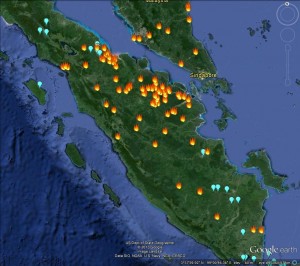- The Brazil nut needs its pollinators.
- How USDA protects plant varieties.
- American dogs are Asian, not European.
IndiaNepal working out how to implement the ITPGRFA.- Kerala’s vegetable terrace gardeners.
- Haven’t heard much about Ug99 lately, have we? Doesn’t mean people aren’t keeping a careful eye on it.
- Climate change 10,000 times faster than vertebrate evolution.
- Why quinoa is not “taking over the world.”
- Not even New Zealand. Though not for want of trying.
- In the meantime, soybeans taking over Africa?
- Aquaculture that’s sustainable and ancient. Includes taro fish ponds, which for some reason seem to me cool beyond measure.
The Indonesian fires and crop wild relatives
I know what you’re wondering. You’re wondering whether those fires in Indonesia which are causing so much trouble with haze in Singapore and other neighbouring places are also endangering any crop wild relatives back home. Well, thanks to the following Twitter exchange with the GIS people at Kew, I now know (or have been reminded, actually) that NASA makes available global data on active fires:
@AgroBioDiverse @worldresource yes with GeoCAT & kml layer import – this is from last 24 hrs http://t.co/3utE5w6cMb pic.twitter.com/RqtpAIsm0n
— KewGIS (@KewGIS) July 10, 2013
We can of course mash that up in Google Earth with, say, the distribution of wild rice (Oryza spp) from Genesys. That would be the little pale blue circles in the map reproduced below.
Which does suggest that at least some of the Indonesian fires may be occurring in wild rice habitats. They may actually be beneficial to some of the weedier species, though, for all I know. Anyway, as ever, it’s nice to have the data. And, just as importantly, be able to play with it.
Brainfood: Leafy greens, Korean rice, Molecular breeding, Poultry conservation, Tree genomes, Pathogen genetics, Grazers and CC, Sustainable rangelands, Available land, Ecosystem services
- Analysis of urban consumers’ willingness to pay a premium for African Leafy Vegetables (ALVs) in Kenya: a case of Eldoret Town. An 80% premium! But in Eldoret. And Nairobi?
- Analysis and comparison of the γ-oryzanol content based on phylogenetic groups in Korean landraces of rice (Oryza sativa L.). Some groups are browner than others.
- What is the SMARTest way to breed plants and increase agrobiodiversity? Just another name for MAS. But some crops are SMARTer than others.
- Conservation of local Turkish and Italian chicken breeds: a case study. Turks can learn from Italians. And probably vice versa, I bet, although that’s not explored as much here.
- Open access to tree genomes: the path to a better forest. Hard to argue with. The open access bit more than the genomes bit.
- Evolution, selection and isolation: a genomic view of speciation in fungal plant pathogens. Know your enemy. Easier to figure out how new species become different than how they stay that way.
- Long-Term Climate Sensitivity of Grazer Performance: A Cross-Site Study. Hotter conditions means poorer forage quality means smaller bison. And maybe cattle. All other things being equal, like genetics, and range management. Which of course they never are.
- Ecosystem function enhanced by combining four functional types of plant species in intensively managed grassland mixtures: a 3-year continental-scale field experiment. See what I mean? And more.
- Estimating the world’s potentially available cropland using a bottom-up approach. Less than you’d think.
- Spatial interactions among ecosystem services in an urbanizing agricultural watershed. Very very limited places provide multiple services, especially crop production and water quality, which means you need to protect huge areas. But they’ll be mosaics.
Nibbles: Sustainable aquaculture, Mekong fish project, Peruvian anchovetas, Ugandan fishing standards, Bangladesh fish celebrations, Beef vs fish, FAO on GIS
- Sustainable fish farming in Spain. With video goodness.
- A project to estimate the value of Mekong fish.
- Eating fish, rather than feeding them to pigs, to conserve them in Peru. The fish, not the pigs. And more on the same fish, but another place. I think it’s the same fish anyway.
- Codex Alimentarius standards are important even to Ugandan artisanal fisherfolk. Also with video goodness.
- It’s National Fish Week in Bangladesh.
- “So should we mourn that the cow is overtaken by the fish?”
- Fish need GIS too.
Nibbles: Ug99, Heirloom & wild tomatoes, Opium, Healthy flavours, Quinoa descriptors, Wild yak community conservation, Phenotyping facility, Tree app, ABS & EU, C4, Barley in Ethiopia, Chinese coffee
- Not totally wild genes protect wheat from Ug99.
- Not really wild Texas Wild tomato brings Texan back to gardening. These in Peru are wild though.
- Speaking of gardening, here’s Michael Pollan on his struggles with opium.
- Wild, healthy fruit flavours becoming more popular on the soft drink market, but not clear to what extent they will come from actual plants, wild or otherwise. You know, plants with yield variation and other inconveniences. Plants that some people rely on for nutrition, by the way.
- Descriptors for quinoa, including the wild species. And more, much more.
- I wonder if there are descriptors for wild yaks.
- New UK facility for phenotyping plants, including wild ones, I’m sure.
- And if those wild UK plants are trees, you can use this app to identify them, before phenotyping them. Assuming you can dig them up and squeeze them into the new facility. Anyway, maybe one of them will be European Tree of the Year.
- Of course, if you wanted access to the genetic resources of such trees, you’d have to deal with the Nagoya Protocol, which the EU is getting to grips with, don’t worry.
- Not many C4 species among UK trees, I guess.
- Teff is C4, but that isn’t stopping people trying to replace it with barley in injira.
- Next thing you know the Chinese will be swapping tea for coffee. No, wait.
